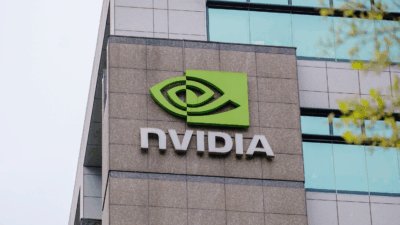Does TV News Have a Home in the Streaming Era?
Big Tech loves movies, TV shows, and live sports. So why has it shown remarkably little appetite for the TV news business?

Sign up for smart news, insights, and analysis on the biggest financial stories of the day.
When it comes to disruption, Silicon Valley has long seen the mainstream media industry as the lowest-hanging fruit. First, tech came for Hollywood. Next, in a recent and ongoing effort, Big Tech came for the lucrative world of live sports.
But the takeover has left one key pillar firmly in the grip of legacy media: the news. The future of the TV news industry is murky, and if old-timers like Warner Bros. Discovery (WBD) and Comcast’s NBCUniversal can’t survive the pivot to streaming, at least at their current scale, a TV news vacuum may be ready for filling. But so far Big Tech has shown remarkably little appetite for the TV news business. Is it something they said?
News Flash
The appeal of the TV news industry has long been obvious: When audiences want to sit and watch the news, they’ll do just about anything. Including sit through ads. Count it as a major selling point for the likes of Netflix and Amazon Prime Video, both of which have recently made hard pivots into the world of advertising. (Netflix co-CEO Ted Sarandos recently remarked the company had no interest in live news, though he also once insisted it would never get into advertising.)
It’s why the sector has remained vital for legacy media players, despite the overall decline in cable and linear TV viewership and its dependency on either cyclical events or spontaneous moments. While none of the parent companies of the three major 24/7 cable news stations — CNN, MSNBC, and Fox News — break out individual figures for their news networks in earnings reports, there are some hints at how lucrative the news business remains:
- Last September, sources who spoke with CNBC said WBD’s CNN was expecting to generate around $1 billion in EBITDA for the full year. That’s roughly in line with the network’s status quo from 2010 through 2020, and a recovery from a dip to around $750 million in 2022.
- The network has fallen to third place in the big three’s ratings race. In fact, primetime viewership in April came in at just about a third of Fox News’ leading 1.98 million viewers, per Nielsen — which gives some indication as to just how valuable its competitors are for their parent organizations too.
Say what you will about this not being the Golden Age of TV journalism (CNN’s current ratings pale compared to the astronomical figures seen during the height of the Gulf War), but nearly 2 million consistent nightly viewers is nothing to scoff at, even for streaming services with subscriber figures north of 200 million. Amazon, for instance, is reportedly paying up to $2 billion per season for a package of NBA games, and semi-weekly regular season NBA games this past year averaged just 1.6 million viewers across ESPN, ABC, and TNT.
And let’s face it, being a major player in news media comes with perks that don’t exactly show up in the quarterly earnings report — namely influence over politics, parties, elections, culture, and so on.
Case in point: The Department of Justice spent nearly two years battling AT&T’s massive acquisition of Time Warner on antitrust grounds, ultimately failing to block the deal, which went through in 2018. But when Disney sought to acquire most of the entertainment assets from direct competitor Fox that same year, the deal flew by regulators with little scrutiny — leading many, including The New York Times editorial board, to wonder if Fox, en route to a massive payday via the asset sale, received favorable treatment thanks in part to Fox News’ friendly coverage of the Trump regime.
The Problem With News: Despite ongoing regulatory battles with antitrust enforcers, Big Tech doesn’t seem keen on using news media as a way to gain friends and influence: The news is more a nuisance that can complicate life for any self-respecting global business behemoth.
Take, for instance, Apple. In 2020, the iPhone maker signed a deal with Jon Stewart — the former and now current host of Comedy Central’s The Daily Show — to host a weekly talk show on Apple TV+. The Problem with Jon Stewart aired for two seasons across the next two years. While not pure journalism, per se, the comedy-news program featured editorial deep dives into timely topics like gun control and climate change, and landed major interviews with prominent national figures, such as SEC chair Gary Gensler and former treasury secretary Larry Summers.
In short: The show was the closest thing to hard-hitting news the streamer had to offer. Perhaps too hard-hitting for Apple.
Just before season three went into production, Stewart decided to walk away, effectively canceling the show. He cited editorial differences over subjects such as China, artificial intelligence, and a planned interview with Federal Trade Commission chairwoman Lina Khan. China, AI, and antitrust are common topics in the Cupertino C-suite, to say the least.
In a recent interview on the The Ringer and Puck’s podcast “The Town”, Stewart went into more detail for the first time, saying Apple executives grew more and more wary over content matter, and increasingly wanted deeper oversight of the show’s editorial direction. “I realized, ‘Oh, our aims do not align in any way,’” Stewart said. “We’re trying to make the best, most insightful execution of the intention that we can make. But they’re protecting a different agenda.”
Of course, business realities and editorial decisions are often at loggerheads in the news business. For content-first companies, it’s the nature of the beast. But for major tech players, for whom content — entertainment, sports, news, or otherwise — remains a balance sheet footnote, it’s an unnecessary headache. Meanwhile, the difference in infrastructure between streaming platforms and cable creates only more deterrents.
In “the old cable business, [companies] would go to conventions and sell to different territories,” Stewart said. “It had a way of quarantining certain troublesome content that didn’t destroy the whole [business]. When Netflix puts something out, or Amazon or Apple, it goes out to everyone all at once. There are no territories. There is no quarantining. There is no ability to say, ‘When we sell that episode to Scandinavia, we may have to make a little bit of an adjustment, but the rest of our markets hold.’”
The globalization of content distribution is not the only difference in incentive structure between streaming and regular old TV. Broadcast news networks — like NBC, CBS, and ABC, for instance — have long been comfortable letting daily news programming be a loss leader. In fact, they have to be: In exchange for providing news to the public, the FCC granted networks exclusive rights to limited airwaves. The internet superhighway allows for no such ulterior motive.
Join the Club: Apple, of course, isn’t the only tech player with a news allergy, televised or otherwise.
In May, Business Insider reported that Meta had seriously considered becoming the primary backer of the Associated Press in 2017 and 2018 (the AP operates as a not-for-profit cooperative and unincorporated association, so this would’ve been essentially an acquisition without technically being an acquisition). Zuckerberg and co. ultimately backed off due to regulatory concerns, sources told BI. The tech giant also considered launching its own news organization at the time, though it abandoned the project over fears of public blowback. Meta has since radically de-emphasized third-party news on its users’ content feeds.
Meanwhile, Elon Musk’s flirtation with news programming on X-née-Twitter ended after just one somewhat tense interview with former CNN anchor Don Lemon. Amazon founder Jeff Bezos has owned The Washington Post for over a decade now, though he seems increasingly tired with its flagging financials.
Headline Blues: Despite the still-steady profits, legacy media may be souring on the news business as well. Disney CEO Bob Iger last year floated putting ABC up for sale (though he quickly did a 180 on the suggestion). Rumors have long circulated that WBD may put CNN up for sale as it navigates the transition to streaming; when the Warner Bros. Discovery merger closed in 2022, Discovery’s leadership team quickly pulled the plug on the nascent, and flailing, CNN+ streaming platform. Should Sony reinvigorate its efforts to acquire Paramount, it could sell subsidiary CBS — who wants the regulatory headache?
It’s understandable that TV news gets a cold shoulder from number-crunchers.
Operating and maintaining a 24/7 newsroom capable of quickly responding to unpredictable events is a costly endeavor. “In sports you know where the cameras are beforehand and everything is exclusive,” Andrew Heyward, former president of CBS News, recently told The Los Angeles Times. “The big difference between sports and news is having to pay to be prepared for the unexpected. It’s a very unattractive financial proposition.”
Worse — while still a money-maker, cable and linear TV is in precipitous decline. In May, streaming’s share of total TV viewership hit an all-time high at 38.8%, according to Nielsen.
Meanwhile, as young consumers get their news from TikTok and Twitter, the only viewers going down with the TV Titanic aren’t exactly advertisers’ most desired demographic. According to Nielsen, the median age of TV news’ audience is, well, perhaps exactly what you may expect: MSNBC’s is 70, Fox News’ is 69, and CNN’s is 67. Broadcasters ABC and CBS cater to a median audience of young whippersnappers, ages 66 and 64, respectively.
In other words: Big Tech may not want in on the TV news business because in just a few decades’ time, there may not be much of an audience for TV news.
To quote Albert Brooks in Broadcast News: How do you like that? We buried the lede.











